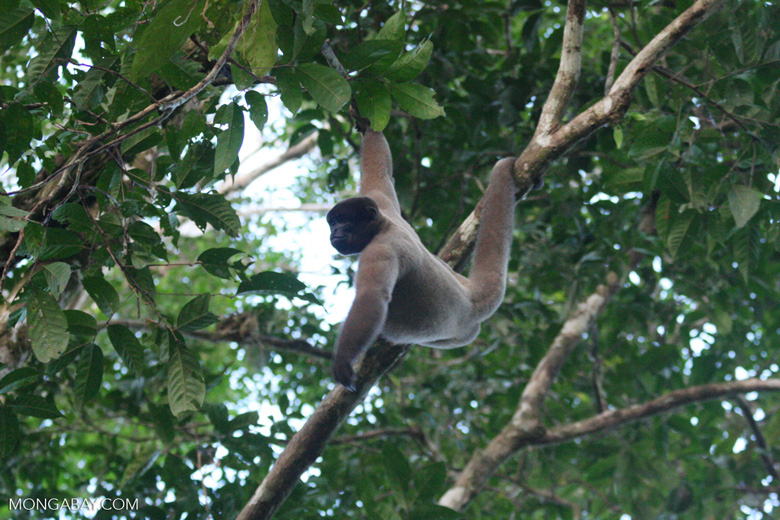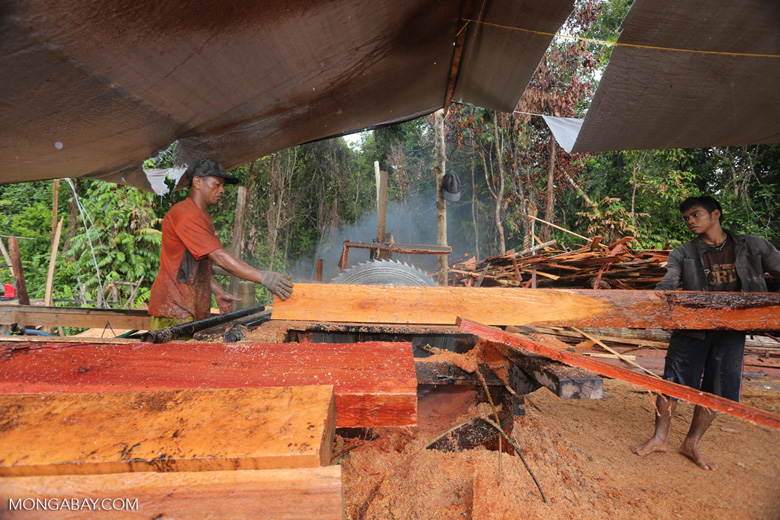- Conservationists agree that keeping forests standing is a necessary part of any carbon solution. But figuring out how to balance that with the increasing global demand for wood has caused a philosophical rift.
- The “zero net deforestation” camp says that limited amounts of industrial logging, following best practices, can be allowed in primary forests.
- But the “zero deforestation” camp maintains that industrial logging presents an unacceptable risk to forests and must be prohibited.
Amid headlines screaming about climate change and ecological collapse, it is easy to forget just how much nature is left. Two parallel rings of so-called “primary forest” — areas largely undisturbed by humans — still circle Earth’s tropics and Arctic. A 2015 study by the United Nation’s Food and Agricultural Organization (FAO) found 4.9 million square miles of primary forest, an area larger than Canada, or about 8.5 percent of the planet’s land area. These territories still harbor the bulk of Earth’s terrestrial biodiversity and hold down a great deal of its carbon.
The majority of these forests — somewhere between three-quarters and 95 percent — exist outside of formal protected areas like national parks. For two decades, forest activists have fought for a binding international agreement protecting these lands. In the early 1990s, the United Nations and World Bank dropped language offering specific protection to primary forests; with the Paris climate talks late last fall, pressure for such a treaty has swelled again. But any agreement will have to reckon with a fundamental dilemma: the world’s forests, intact and degraded alike, are caught between the needs of a warming planet and the needs of human beings for fuel, fiber, food, and building materials.

On the one hand, it’s generally agreed in conservationist circles that keeping forests standing is a necessary part of any carbon solution. On the other hand, there is an increasing global demand for wood — one of the lowest carbon footprint building materials available — for both luxury goods and the basic materials of life.
The same trees cannot easily meet both those goals. And despite a boom in tree farms over the last several decades, the bulk of the world’s lumber still comes from natural — that is, not artificially cultivated — forests, among them primary ones.
So the international conservation community is split between two philosophical camps when it comes to the issue of logging in primary forests. The camps are known by two confusingly similar names: “zero net deforestation” and “zero deforestation.” Both sides agree on the fundamentals — the importance of saving primary forests to slow both mass extinction and climate change and the need to balance this imperative with humanity’s need for wood. But they disagree on how best to accomplish them. One side says that limited amounts of industrial logging, following best practices, can be allowed in primary forests. The other side says that industrial logging presents an unacceptable risk to forests and must be prohibited.

What is a forest?
One serious problem in this debate is that there is no universally agreed upon definition of what a “forest” is, let alone a primary forest. According to one definition, favored by the FAO, a forest is defined by tree cover: “land spanning more than 0.5 hectares with trees higher than 5 meters and a canopy cover of more than 10 percent.” According to the other main definition (which the FAO also acknowledges), the designation is based on land use: forests are marked by being free from agriculture.
But a pine or oil-palm plantation may meet the tree-cover definition. Conversely, certain swaths of primeval-looking jungle in places like Brazil and Indonesia have been cultivated by people for thousands of years. Hence the proliferation of terms to describe the thing variously called “primary forest,” “old-growth forest,” “virgin forest,” or “intact forest.” Each one highlights a slightly different forest characteristic and has a slightly (or dramatically) different political shade.

This article follows the FAO definition of a primary forest as “a naturally regenerated forest of native species, where there are no clearly visible indications of human activities and the ecological processes are not significantly disturbed.” These are forests that either have never been industrially logged (“virgin forest”) or that were logged so long ago that the great canopy trees have had time to regenerate and mature. Though primary forests may sustain populations of hunting or foraging people, the dominant forces on the landscape are natural as opposed to human.
The term “deforestation” means the clearing of forest. It often precedes “conversion,” the changing of primary forest lands to some other use, whether small farms, cattle ranches, or tree plantations.
What virtually everyone in this debate agrees on is that primary forests have an outsized role in regulating Earth’s carbon cycle. A tree is about half carbon by weight. When it burns, whether in a fire or in the guts of microbes dissolving it on the forest floor, that carbon binds with atmospheric oxygen to become carbon dioxide, the gas that drives climate change. The reverse is also true. Growing trees pull carbon from the air.
“We talk a lot about the role of industry emissions in climate change, and that’s a big factor,” Bronson Griscom, who heads the Forest Carbon Science unit at the Nature Conservancy, told Mongabay. “But 96 percent of carbon flux in the atmosphere comes from living things. The only cost-effective technology we’ve yet found to sequester carbon is plants.”
Forests, especially those burned for farmland, release about ten percent of global carbon emissions. According to Griscom, forests also pull about half of human-caused carbon emissions out of the air. Which is to say if it weren’t for forests, the climate problem would be about twice as bad as it is. And a disproportionate amount of that carbon, hundreds of years’ worth, is currently sequestered in the ancient bodies of trees in primary forests. These can hold as much as 70 percent more carbon than forests that have been logged.

Zero net deforestation: responsible logging can help protect forests
One position — held by global NGOs like the World Wildlife Fund and the Nature Conservancy — is that some logging for timber in primary forests is acceptable as long as it is done following best practices and offset by forest growth or regeneration elsewhere.
According to the Nature Conservancy’s Griscom, the case for allowing logging in primary forests starts with realizing that the days of clear-cutting for timber are largely over, at least in the tropics. Griscom has spent his career working on the forest frontiers in countries like Brazil and Indonesia, researching how forests can be used to solve climate change. He’s a respected voice on the science of carbon and carbon sequestration.
Griscom said that most tropical forests have relatively few valuable trees per hectare — big, high-dollar species like rosewood or mahogany. So rather than raze the forest, loggers target the big trees and leave the rest. In many of these forests, he said, few traces of the logging remains.
In all the time he has spent in the tropics, Griscom said, “Maybe once or twice have I been in a forest, outside of officially protected areas, that hadn’t been logged. A hundred, fifty, ten years ago, someone went in and took out the mahogany. And now you can’t even tell they were there. There are monkeys in the trees, the whole thing.”

To be clear, neither Griscom, the Nature Conservancy, nor the World Wildlife Fund support logging of virgin forests, the ancient old-growth stands that have never been logged. “The frontier should not advance,” Griscom said.
Neither does he support conversion of primary forests, even degraded ones, into tree plantations, preferring to see former cattle pastures sprouting palm and pine plantations.
But Griscom wrestles with a fundamental problem. With the world’s population and timber demand growing, “it’s not clear how much more forest we can take offline” by placing it in parks, he said. “The tough question is where best to site those protected areas; where populations will support them. Loggers aren’t going to go away just because we wish them away.”
The trouble as he sees it is less with making laws protecting land than with the realpolitik question of getting people to follow them. Interpol and the U.N.’s Environment Programme estimate that as much as 90 percent of timber exports from some key tropical countries are illegal, raising serious questions about the value of official restrictions.
Often, Griscom conceded, timber has been “mined like coal” at great ecological cost by faraway corporations with few ties to the land they log. But it doesn’t have to be that way. In Mexico and Guatemala, commercial community forestry operations have been as successful as officially protected areas in keeping the forest from being converted, he said. In poorly policed states, he argued, responsible forestry operations can be like “good bacteria in your gut — they keep out the bad ones. The loggers can cause a problem, but they can also be gatekeepers.”

Rather than fighting loggers, Griscom argues for recruiting them. At its root logging is “the only global commodity product aligned with conservation goals,” he said. If the goal is keeping forests from being converted into farmland, then it helps if cash-strapped governments and municipalities see a financial benefit from forests that helps counterbalance the benefit from razing them and throwing up an oil-palm plantation.
Griscom supports expansion of protected areas. “But the tough question to confront is where society will accept them. Where it’s not feasible, we should accept the notion of working forests and make them work as well as they can,” he said.
To that end, Griscom, speaking for the zero net deforestation camp, would like to see responsible logging in some primary forests incentivized and encouraged, especially by payments to national or provincial governments under a REDD+ type system. “We’d like Indonesia to go to the forestry sector and say, ‘Hey, we’re getting money if we cut emissions, and we’ll pay you to help,’” he said.
Zero deforestation: logging in primary forests leads inexorably to their destruction
The opposing position, held by a coalition of groups called International Action on Primary Forests (IntAct), as well as a number of scientists specializing in forestry and conservation, argues that allowing any logging in a primary forest paves a path to its destruction. IntAct, which includes groups like the Sierra Club, Global Witness, and Greenpeace, argues that all industrial activity, including logging, must be kept out of primary forests entirely.
The problem, according to Cyril Kormos, Vice President for Policy at the Wild Foundation, one of IntAct’s signatories, is that logging poses unacceptable risks to primary forests.
“Maybe most importantly, once you log, the remaining forest is at tremendous risk because now there are roads, and the valuable timber is gone. That means [that] converting the forest to industrial agriculture becomes the most attractive option economically,” he said.

Take the idea of selective logging itself, one of the tenets of the tropical forestry industry’s best practices. Kormos emphasized that it is unquestionably better than conventional logging, where loggers may not be concerned about collateral damage, and much better than clear-cutting and converting the forest to a plantation or pasture. But he said that it still comes with serious costs.
Felling the big, lucrative trees can still inflict significant collateral damage on surrounding trees, no matter how much care loggers take. Logging still results in a lot of dry “slash” on the forest floor, making the forest more prone to fire. And about half of the average tree ends up as waste on the sawmill and forest floor, its carbon slowly vaporizing into greenhouse gas.

Kormos argued that while there may be hypothetical levels at which logging is in fact sustainable in primary tropical forests, it’s a moot point. Commercial operations can’t make much money at those levels, with the result that either forestry laws set harvests at unsustainable levels or logging operations simply cheat.
For logging of tropical forests to be truly sustainable, intensity has to be very low (fewer than five trees per hectare) and logging rotations have to be very long (60 years or more), as summarized in a paper in Bioscience that Kormos co-authored with Barbara Zimmerman, a forest ecologist with the NGO International Conservation Fund of Canada. That’s decades longer than what logging laws require.
In addition, logging companies have to undertake time-consuming and expensive forestry practices, including planting seedlings and tending them until they reach pole size. If these requirements aren’t met, the target hardwood timber species being logged don’t regenerate. “This is why mahogany is commercially extinct over such a big part of its range,” Kormos said.
Forests are large, complex systems, held together through dense webs of relationships between pollinators and plants; seed dispersers and plants; predators and prey. Start knocking holes in that web — as loggers do when they, say, pull out all the big mahogany trees — and you begin to disturb the equilibrium. You might, for instance, change how the forest regenerates, change the composition of species, or make the forest drier and more vulnerable to fire.
“With industrial activity in primary forests, you rapidly pass the threshold of what the forest can recover from and retain all of its primary-forest values,” Kormos said.
Kormos emphasized that if one cut was all that ever happened it might not be so bad. But loggers build roads, and once a road exists it is very difficult to control its use and keep an area conserved. A second cut may pull out species of lesser value. People use logging roads for mining and small-scale agriculture. Hunters move in to access game.
Finally, when everything worth anything has been taken out of the forest, he said, “the last thing of value is the land itself.” The surviving forest is very often cut down and converted into industrial plantations or pasturage.
The result of this, according to a paper in Biological Conservation that examines timber production in six countries, is a sharp spike in production followed by a dramatic fall-off — a boom and bust pattern similar to that found in many nonrenewable resources. “Unless something fundamental changes,” the researchers note in the paper, “we believe tropical forests will be harvested and cleared apace.”

So IntAct tries to change something fundamental by taking a hard line: no industrial activity in primary forests at all. “The position we’re taking is very simple, because the track record is really bad so far,” Kormos said. “We aren’t going to stay at 1.5 or 2 degrees Celsius unless tropical countries stop deforesting, and we haven’t seen much ability to manage industrial activity in tropical forests. So we say keep it out.”
“Law is a circuit between imagination and the material world,” writes Duke University environmental law professor Jedediah Purdy. Visions of nature become laws; and those laws morph people’s behavior, changing landscapes in their wake. The two worldviews of zero net deforestation and zero deforestation represent different ways of imagining the role of primary forests in the world: as productive land or as protected wilderness.
And though the debate is somewhat academic at this point, if forestry activists get their way, the next international climate agreement will contain provisions on how tropical countries can best protect their forests. But which provisions? The future of now-undisturbed corners of forests from Indonesia to the Congo will rest on the result.


Citations
- (2015). Global Forests Resource Assessment 2015. Food and Agriculture Organization of the United Nations: Rome, Italy.
- Nellemann, C., INTERPOL Environmental Crime Programme (eds) (2012). Green Carbon, Black Trade: Illegal Logging, Tax Fraud and Laundering in the Worlds Tropical Forests. A Rapid Response Assessment. United Nations Environment Programme, GRID-Arendal.
- Blackman, A. (2015). Strict versus mixed-use protected areas: Guatemala’s Maya Biosphere Reserve. Ecological Economics 112:14–24.
- Zimmerman, B.L. and Kormos, C.F. (2012). Prospects for Sustainable Logging in Tropical Forests. Bioscience. Bioscience 62(5): 479-487.
- Shearman, P., Bryan, J., Laurance, W.F. (2012). Are We Approaching Peak Timber in the Tropics? Biological Conservation 151(1):17-21.
- Purdy, J. (2015). After Nature: A Politics for the Anthropocene. Harvard University Press.

